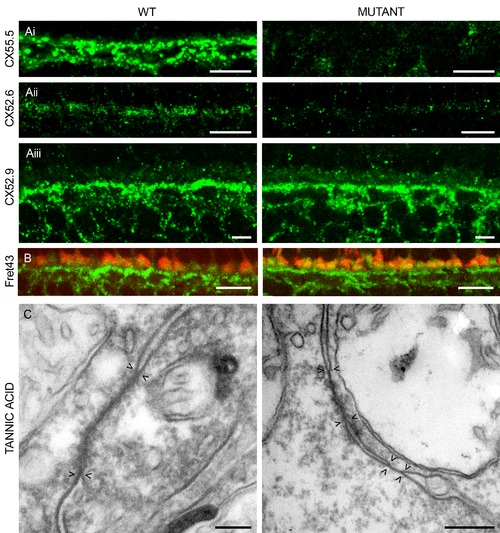- Title
-
Synaptic transmission from horizontal cells to cones is impaired by loss of connexin hemichannels
- Authors
- Klaassen, L.J., Sun, Z., Steijaert, M.N., Bolte, P., Fahrenfort, I., Sjoerdsma, T., Klooster, J., Claassen, Y., Shields, C.R., Ten Eikelder, H.M., Janssen-Bienhold, U., Zoidl, G., McMahon, D.G., and Kamermans, M.
- Source
- Full text @ PLoS Biol.
|
Localization of cellular markers in retinas from wild-type and mutant zebrafish. The organization of the outer retina was evaluated by the distribution of a number of cellular markers for double cones (A, FRet43) in red, horizontal cells (B, GluR2) in green, OFF-bipolar cells (C, GluR4) in red, and interplexiform cells (E, TH) in red. The blue stain is the nuclear marker DAPI. No difference in the distribution of these markers could be observed. In both preparations, GluR2 forms horseshoe-like structures in the OPL (B, D). Previous studies have shown that these structures are horizontal cell dendrites invaginating the cone terminal [57], [57], [58]. (E) TH labels interplexiform cells and the synapses these cells make onto horizontal cells. The immunoreactivity pattern is similar in wild-type and mutant retinas. These results indicate that all major neuron types in the OPL have developed normally. (A to E): Scale bar = 10 μm. (F) Ultrastructure of the cone synaptic terminal in wild-type (left) and mutant (right) retinas. No differences were found in the ultrastructural organization of the cone synaptic terminal. In both animal models, the characteristic shape of the synaptic triad was easily identified. R, synaptic ribbon; Sp, spinules; HC, horizontal cell; * bipolar cell. Scale bar = 0.5 μm. EXPRESSION / LABELING:
|
|
Cx52.9 co-localizes with GluR2, Cx55.5, and Cx52.6 in zebrafish retinas. The top panel shows co-localization of the Cx52.9 (green) antibody and GluR2-IR (red). GluR2 labels the tips of horizontal cell dendrites. This co-localization shows that Cx52.9 is present at the horizontal cell dendrites. Middle panel: Double labeling of Cx52.9 (green) and Cx55.5 (red). Red, green, and yellow plaques can be found, indicating that in some (parts) of the gap-junctions Cx55.5 co-localizes with Cx52.9. The bottom panel shows that there is co-localization of Cx52.6 (red) and Cx52.9 (green). Also for this combination, areas of co-expression of the two connexins can be found. This means that the three connexins co-localize in gap-junctions between horizontal cells. Scale bar = 10 μm (top panel). Scale bar = 5 μm (middle and bottom panel). EXPRESSION / LABELING:
|
|
Localization and expression of connexins expressed by horizontal cells in wild-type and mutant zebrafish. (A) Immunocytochemical staining with antibodies against Cx55.5 (i), Cx52.6 (ii), and Cx52.9 (iii). Cx55.5-IR and Cx52.6-IR are absent in the mutant, whereas Cx52.9-IR remains present or even becomes stronger. Scale bar = 10 μm. (B) Double labeling of Cx52.9 (green) and FRet43 (red), a label for double cones. The Cx52.9-IR and FRet43-IR are closely associated, indicating that Cx52.9-IR is present in the dendrites of horizontal cells invaginating the cone synaptic terminal in both wild-type and mutant. Scale bar = 10 μm. (C) Tannic acid staining of gap-junctions in wild-type and mutant retinas. Pairs of arrow heads indicate the extent of the gap-junction. Often the gap-junctions in the mutant seem to be “split” as is illustrated in this figure. On average, gap-junctions are smaller in the mutant retinas. Scale bar = 0.5 μm. |

qPCR and western blot data confirm absence of Cx55.5 and Cx52.6. (A) Immunoreactivity patterns of Cx55.5, Cx52.6, and Cx52.9 antibodies in membrane samples of wild-type and C54X mutant zebrafish retinas. On Western blots derived from 8-10% SDS-PA gradient gels on which membrane samples (40 μg of each) of wild-type and mutant zubrafish retinas were separated, the Cx55.5 and Cx52.6 detected a double band with a molecular weight in the expected range (black asterisk) in the wild-type, but not the mutant retina (black asterisk). In contrast, the expression of Cx52.9 protein appeared to be unaffected in the mutant (white asterisk) and a protein with the appropriate molecular weight of Cx52.9 was detected in both membrane samples, wild-type and mutant. (B) qPCR experiments revealed a significant down regulation of Cx55.5 and Cx52.6 mRNA in mutant fish (p<0.001). Steady state Cx52.9 mRNA levels were not affected. |

Horizontal cell properties in wild-type and mutant zebrafish. (A) Ihemi in wild-type (black) and mutants (red) differ significantly. Whole cell currents of a dissociated horizontal cell when stepped to 60 mV and +60 mV, respectively. In the mutant, the inward PHENOTYPE:
|
|
Feedback measured in cones is reduced in the mutant zebrafish (A) Light-induced feedback responses in wild-type (left) and mutant (right) zebrafish cones. Horizontal cells were hyperpolarized by full-field 1 s flashes of light while the recorded cone was saturated with a 20 µm spot of bright light. (B) IV relation of a cone ICa in control (green), 50 µM DNQX (red), and 30 µM KA (black) in wild-type (Bi, left) and mutant (Bii, left). Averaged DNQX- (red) and KA- (black) induced currents in wild-type (Bi, right) and mutants (Bii, right). The DNQX-induced current is significantly reduced in the mutant compared to the current in wild-type. PHENOTYPE:
|

Optokinetic response of mutant zebrafish is reduced. (A) Eye movements of a wild-type zebrafish larva (black, right eye; red, left eye). Timing of the stimulus is indicated in the bottom trace. (B) Optokinetic gain as function of contrast for 13 wild-type (black) and 13 mutant (red) zebrafish. Over the whole contrast range the wild-type performed significantly better than the mutant. (C) In the mutant, reduction in optokinetic gain is stronger for high temporal frequencies (1.0 cycle per second) than for low temporal frequencies (0.25 cycle per second) ( PHENOTYPE:
|




